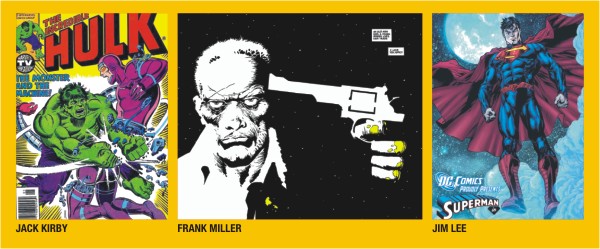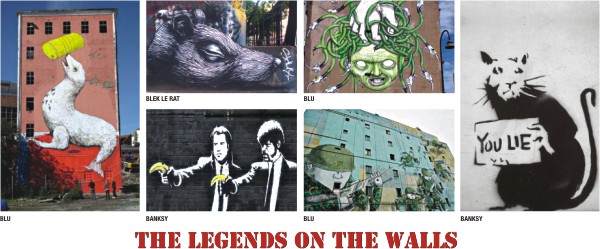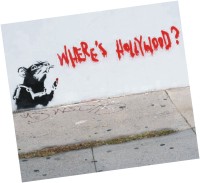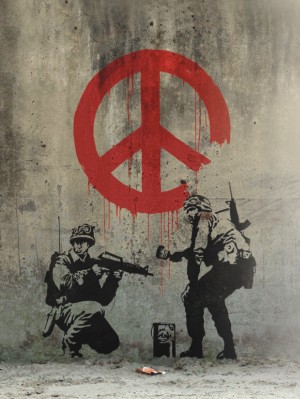
“A great artist is always before his time or behind it.”
It's been a long while since comic books were just stick figures drawn with speech bubbles made to make readers have a “jolly good laugh”. Today, comics aren't just about making people laugh; some make us think, some make us cry, but importantly they inspire and amaze us; and the artwork plays a role most paramount. This issue, we look at some of the best of comic book artists.
Herge (Tintin)
Herge was the pen name of Georges Prosper Remi who was a Belgian comic book writer and artist who gave the world Tintin; that little fellow with the most brilliant dog who kept on going on adventures all around the world, with his bad-mouthed sailor friend. What makes Herge special is that he single-handedly wrote and drew out each and every one of Tintin's adventures. Also, his artwork involves flat colours that manage to give off way more depth than many modern artists convey with multiple shading techniques. AND to top it off, this was all done more than 50 years ago. The only unfortunate bit is that Herge's other projects weren't any good and thus it was just Tintin which worked out; but in the end, it's still Tintin.
David Finch(The New Avengers, The New 52: Dark Knight)
David Finch worked with DC and Marvel both over the recent years; while being relatively new, he's still acquired much fame from the comic book. His most notable work would be the very recent Dark Knight in DC's The New 52 series. Although his story telling might prove to wear a little thin, his artwork is brilliant. With incredible attention to every detail, his portrayal of Batman is the perfect image of the modern Dark Knight: buff, dark and mean to the end. The proper gritty reboot.
Frank Miller (Ronin, 300, Sin City)
Everyone's heard of Frank Miller. Not only is he an amazing artist, his ability to wield a story is paralleled by only a few in this world. He's written countless comics but his most notable and arguably his best ones are the three mentioned above. The fact that he has three books to choose from as to which is best might be impressive; what's even more impressive is that they all differ in various ways; what's EVEN more impressive is that his artwork is undeniably amazing in all three of them. From Ronin's sword fights to the Spartan blades to Sin City's cruel and morbid atmosphere, this man is truly an inspiration to any artist.
Dave McKean (Arkham Asylum, Sandman)
Dave McKean is like the Da Vinci of modern art; he's a comic book artist but his work includes collages, photography, paintings, drawing and sculpting. What makes him this writer's favourite is the fact that he incorporates every one of those things into his artwork. The artwork in Arkham Asylum is stunning and Sandman is even better. McKean works with shapes and colours; he mixes and mashes them together to create these amazing pictures which would seem like random brush strokes at first but then turn out to be absolute genius.
Jim Lee (X-Men Legacy, The New 52)
Jim Lee has worked for both Marvel and DC, as you can see from the title. He made his bid for fame with X-Men: Legacy and his style of sharper, more modern heroes have gained him quite a few fans. After he worked with Image Comics [a break away from Marvel Comics], he eventually made the move to DC Comics, where he has instigated the reboot of much loved superheroes and they look pretty good.
Humberto Ramos (Impulse, The Amazing Spider-man)
A relative young comics artist on this list, Ramos also has the touch that moves comics forward. He has been extremely successful with the Amazing Spider-man series and while his artwork is progressive, it is distinctly different from the reboot of Jim Lee, focused more on presentation rather than revamping the whole look. With hordes of fans and copycats, Humberto Ramos' star is certainly on the rise.
Jack Kirby (Too many to name)
This list would be incomplete without him. He was part of the duo (the other being Stan Lee) who gave the comics world some of their most loved characters and groups, The Hulk, Fantastic Four and Avengers to name a few. Considering the kind of paper and print he had to work with, his use of colours is brilliant. But even more than that is his imagination and his application of it. From drawing different worlds to different races to the rippling muscles of Hulk, Kirby has proved himself and carved out a seat above all other comic book artists; the image of a pioneer and a revolutionary.


By That Guy
I was asked to write a piece on the most notable graffiti artists in the world. To be quite honest, I see this as a futile exercise. What good is writing describing art? Art cannot be described so simply, and I especially do not consider myself capable of this. Therefore my aim is not to tell you how great their art is. This is simply an introduction on how awesome graffiti can be as an art form.
 Blek Le Rat is known as the father of stencil graffiti. In 1981, stencilled rats began appearing on the streets of Paris, calling the rat the “only free animal in the city” and one “that spreads the plague, like street art”. His name, Blek Le Rat came from a childhood cartoon, using the word Rat as an anagram for Art. His style was influenced by the early graffiti artists of New York which he saw in the early 70s but he soon developed his own signature style, attributing it to the difference in architecture between Paris and NYC. He invented life-size stencil arts and has been and continues to be a major influence to pretty much all of today's “guerrilla” artists and to all graffiti artists as a whole.
Blek Le Rat is known as the father of stencil graffiti. In 1981, stencilled rats began appearing on the streets of Paris, calling the rat the “only free animal in the city” and one “that spreads the plague, like street art”. His name, Blek Le Rat came from a childhood cartoon, using the word Rat as an anagram for Art. His style was influenced by the early graffiti artists of New York which he saw in the early 70s but he soon developed his own signature style, attributing it to the difference in architecture between Paris and NYC. He invented life-size stencil arts and has been and continues to be a major influence to pretty much all of today's “guerrilla” artists and to all graffiti artists as a whole.
TRACY 168, or as he is known more legally, Michael Tracy, is one of the grandfathers of graffiti. You thought Blek Le Rat's been around forever, this dude's been taggin' walls since the early 70's. In fact, he's one of the NYC inspirations of Blek Le Rat, who in turn inspired the incredibly famous Banksy. TRACY 168 is credited with inventing “wildstyle” graffiti, one of the most intricate and complex forms consisting of explosions of colour and stylised lettering interwoven and overlapping. These are extremely difficult and are considered one of the greatest challenges a graffiti artist can undertake.
German artist, Seak has a very cool style to his graffiti. He draws aliens and monsters and other creatures. But anyone can do that (to some extent). What sets him apart is his stylising and how he adds the 3D feature to his work. His work over the past 20 years has injected new elements to the spectrum of street art. The man says his is a journey to find the absolute core, the soul of graffiti.
Blu's art is abundant online but frustratingly little is known about the man himself. What little is known about him is that he's Italian and he's celebrated for his compelling art style which borders on the surrealistic. Look, it's incredibly hard to describe the art that Blu does, so instead refer to the pictures.
 Dondi White was one of the artists responsible for moving graffiti out of the seedy underbelly of society ruled by thugs and gangbangers to the realm of fine art. He covered trains with massive art pieces using many pseudonyms but you could always tell it was Dondi, with his signature style. He came to be known as “Style Master General” among graffiti artists because his lettering more or less set the standard for artists today. He passed away in 1998 but is remembered fondly amongst street art circles.
Dondi White was one of the artists responsible for moving graffiti out of the seedy underbelly of society ruled by thugs and gangbangers to the realm of fine art. He covered trains with massive art pieces using many pseudonyms but you could always tell it was Dondi, with his signature style. He came to be known as “Style Master General” among graffiti artists because his lettering more or less set the standard for artists today. He passed away in 1998 but is remembered fondly amongst street art circles.
In the 70s, females didn't do graffiti. It just didn't happen. But Lady Pink thought, screw that. She had to hop fences, prove she wasn't just a thug with spray paint and, more importantly, keep up with the men. In a few months, she gained the respect of the entire NYC graffiti community. She was one who was featured in the art world's first graffiti based shows. She juggled her time between fancy art shows and tagging dark train tunnels. Today she still does murals but now they're commissioned and legal.
What can actually be said of Banksy? Everyone knows Banksy. He's THE most well known graffiti artist out there. His art has popped up all over the world. Despite this, his identity remains a mystery. His stencil based art is generally satirical, poking fun at society, commercialism, war and the police. He started out in Bristol's graffiti scene in the early 90s as one of the Dry BreadZ crew. This man is all over the internet.
So yeah. Doodle. Practise. Try it out on the walls of your room before you decide to take it outside. Who knows. Someday, right?
